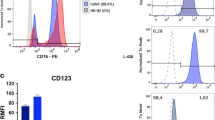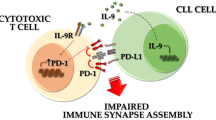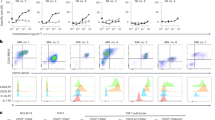Abstract
The huKS-IL2 immunocytokine (IC) consists of IL2 fused to a mAb against EpCAM, while the hu14.18-IL2 IC recognizes the GD2 disialoganglioside. They are under evaluation for treatment of EpCAM+ (ovarian) and GD2+ (neuroblastoma and melanoma) malignancies because of their proven ability to enhance tumor cell killing by antibody-dependent cell-mediated cytotoxicity (ADCC) and by antitumor cytotoxic T cells. Here, we demonstrate that huKS-IL2 and hu14.18-IL2 bind to tumor cells via their antibody components and increase adhesion and activating immune synapse (AIS) formation with NK cells by engaging the immune cells’ IL-2 receptors (IL2R). The NK leukemia cell line, NKL (which expresses high affinity IL2Rs), shows fivefold increase in binding to tumor targets when treated with IC compared to matching controls. This increase in binding is effectively inhibited by blocking antibodies against CD25, the α-chain of the IL2R. NK cells isolated from the peritoneal environment of ovarian cancer patients, known to be impaired in mediating ADCC, bind to huKS-IL2 via CD25. The increased binding between tumor and effector cells via ICs is due to the formation of AIS that are characterized by the simultaneous polarization of LFA-1, CD2 and F-actin at the cellular interface. AIS formation of peritoneal NK and NKL cells is inhibited by anti-CD25 blocking antibody and is 50–200% higher with IC versus the parent antibody. These findings demonstrate that the IL-2 component of the IC allows IL2Rs to function not only as receptors for this cytokine but also as facilitators of peritoneal NK cell binding to IC-coated tumor cells.







Similar content being viewed by others
References
Richards JM (1989) Therapeutic uses of interleukin-2 and lymphokine-activated killer (LAK) cells. Blood Rev 3:110–119
Curiel TJ, Coukos G, Zou L, Alvarez X, Cheng P, Mottram P, Evdemon-Hogan M, Conejo-Garcia JR, Zhang L, Burow M, Zhu Y, Wei S, Kryczek I, Daniel B, Gordon A, Myers L, Lackner A, Disis ML, Knutson KL, Chen L, Zou W (2004) Specific recruitment of regulatory T cells in ovarian carcinoma fosters immune privilege and predicts reduced survival. Nat Med 10:942–949
Nelson BH (2008) The impact of T-cell immunity on ovarian cancer outcomes. Immunol Rev 222:101–116
Bubenik J, Indrova M, Perlmann P, Berzins K, Mach O, Kraml J, Toulcova A (1985) Tumour inhibitory effects of TCGF/IL-2/-containing preparations. Cancer Immunol Immunother 19:57–61
Bubenik J, Perlmann P, Indrova M, Simova J, Jandlova T, Neuwirt J (1983) Growth inhibition of an MC-induced mouse sarcoma by TCGF (IL 2)-containing preparations. Preliminary report. Cancer Immunol Immunother 14:205–206
Rosenberg SA, Lotze MT, Muul LM, Chang AE, Avis FP, Leitman S, Linehan WM, Robertson CN, Lee RE, Rubin JT et al (1987) A progress report on the treatment of 157 patients with advanced cancer using lymphokine-activated killer cells and interleukin-2 or high-dose interleukin-2 alone. N Engl J Med 316:889–897
Lotze MT, Matory YL, Rayner AA, Ettinghausen SE, Vetto JT, Seipp CA, Rosenberg SA (1986) Clinical effects and toxicity of interleukin-2 in patients with cancer. Cancer 58:2764–2772
Lode HN, Xiang R, Becker JC, Gillies SD, Reisfeld RA (1998) Immunocytokines: a promising approach to cancer immunotherapy. Pharmacol Ther 80:277–292
Reisfeld RA, Becker JC, Gillies SD (1997) Immunocytokines: a new approach to immunotherapy of melanoma. Melanoma Res 7(Suppl 2):S99–S106
Connor JP, Felder M, Hank J, Harter J, Gan J, Gillies SD, Sondel P (2004) Ex vivo evaluation of anti-EpCAM immunocytokine huKS-IL2 in ovarian cancer. J Immunother 27:211–219
Neal ZC, Yang JC, Rakhmilevich AL, Buhtoiarov IN, Lum HE, Imboden M, Hank JA, Lode HN, Reisfeld RA, Gillies SD, Sondel PM (2004) Enhanced activity of hu14.18-IL2 immunocytokine against murine NXS2 neuroblastoma when combined with interleukin 2 therapy. Clin Cancer Res 10:4839–4847
Osenga KL, Hank JA, Albertini MR, Gan J, Sternberg AG, Eickhoff J, Seeger RC, Matthay KK, Reynolds CP, Twist C, Krailo M, Adamson PC, Reisfeld RA, Gillies SD, Sondel PM (2006) A phase I clinical trial of the hu14.18-IL2 (EMD 273063) as a treatment for children with refractory or recurrent neuroblastoma and melanoma: a study of the Children’s Oncology Group. Clin Cancer Res 12:1750–1759
Johnson EE, Lum HD, Rakhmilevich AL, Schmidt BE, Furlong M, Buhtoiarov IN, Hank JA, Raubitschek A, Colcher D, Reisfeld RA, Gillies SD, Sondel PM (2008) Intratumoral immunocytokine treatment results in enhanced antitumor effects. Cancer Immunol Immunother 57:1891–1902
Wagner K, Schulz P, Scholz A, Wiedenmann B, Menrad A (2008) The targeted immunocytokine L19-IL2 efficiently inhibits the growth of orthotopic pancreatic cancer. Clin Cancer Res 14:4951–4960
Schliemann C, Palumbo A, Zuberbuhler K, Villa A, Kaspar M, Trachsel E, Klapper W, Menssen HD, Neri D (2009) Complete eradication of human B-cell lymphoma xenografts using rituximab in combination with the immunocytokine L19-IL2. Blood 113:2275–2283
Wong JY, Chu DZ, Williams LE, Liu A, Zhan J, Yamauchi DM, Wilczynski S, Wu AM, Yazaki PJ, Shively JE, Leong L, Raubitschek AA (2006) A phase I trial of (90)Y-DOTA-anti-CEA chimeric T84.66 (cT84.66) radioimmunotherapy in patients with metastatic CEA-producing malignancies. Cancer Biother Radiopharm 21:88–100
Wong JYC, Chu DZ, Yamauchi DM, Williams LE, Liu A, Wilczynski S, Wu AM, Shively JE, Doroshow JH, Raubitschek AA (2000) A phase I radioimmunotherapy trial evaluating 90yttrium-labeled anti-carcinoembryonic antigen (CEA) chimeric T84.66 in patients with metastatic CEA-producing malignancies. Clin Cancer Res 6:3855–3863
Lyu MA, Kurzrock R, Rosenblum MG (2008) The immunocytokine scFv23/TNF targeting HER-2/neu induces synergistic cytotoxic effects with 5-fluorouracil in TNF-resistant pancreatic cancer cell lines. Biochem Pharmacol 75:836–846
Gillies SD, Reilly EB, Lo KM, Reisfeld RA (1992) Antibody-targeted interleukin 2 stimulates T-cell killing of autologous tumor cells. Proc Natl Acad Sci USA 89:1428–1432
Xiang R, Lode HN, Dolman CS, Dreier T, Varki NM, Qian X, Lo KM, Lan Y, Super M, Gillies SD, Reisfeld RA (1997) Elimination of established murine colon carcinoma metastases by antibody-interleukin 2 fusion protein therapy. Cancer Res 57:4948–4955
Ko YJ, Bubley GJ, Weber R, Redfern C, Gold DP, Finke L, Kovar A, Dahl T, Gillies SD (2004) Safety, pharmacokinetics, and biological pharmacodynamics of the immunocytokine EMD 273066 (huKS-IL2): results of a phase I trial in patients with prostate cancer. J Immunother 27:232–239
Shusterman S, London W, Gillies SD, Hank JA, Voss S, Seeger RC, Reynolds CP, Kimball J, Albertini MA, Wagner B, Gan J, Eickhoff J, DeSantes KD, Cohn SL, Hecht T, Gadbaw B, Reisfeld RA, Maris JM, Sondel PM (2010) Anti-tumor activity of hu14.18-IL2 in relapsed/refractory neuroblastoma patients: a Children’s Oncology Group (COG) phase II study. J Clin Oncol 28:4969–4975
Yu AL, Gilman A, Ozkaynak MF, London WB, Kreissman S, Chen H, Smith M, Anderson B, Villablanca J, Matthay KK, Shimada H, Grupp SA, Seeger R, Reynolds CP, Buxton A, Reisfeld RA, Gillies SD, Cohn SL, Maris JM, Sondel PM (2010) Chimeric Anti-GD2 antibody with GM-CSF, IL2 and 13-cis retinoic acid for high-risk neuroblastoma: a children’s oncology group (COG) phase 3 study. N Engl J Med 363:1324–1334
Becker JC, Pancook JD, Gillies SD, Furukawa K, Reisfeld RA (1996) T cell-mediated eradication of murine metastatic melanoma induced by targeted interleukin 2 therapy. J Exp Med 183:2361–2366
Pancook JD, Becker JC, Gillies SD, Reisfeld RA (1996) Eradication of established hepatic human neuroblastoma metastases in mice with severe combined immunodeficiency by antibody-targeted interleukin-2. Cancer Immunol Immunother 42:88–92
Becker JC, Pancook JD, Gillies SD, Mendelsohn J, Reisfeld RA (1996) Eradication of human hepatic and pulmonary melanoma metastases in SCID mice by antibody-interleukin 2 fusion proteins. Proc Natl Acad Sci USA 93:2702–2707
Gillies SD, Lan Y, Lo KM, Super M, Wesolowski J (1999) Improving the efficacy of antibody-interleukin 2 fusion proteins by reducing their interaction with Fc receptors. Cancer Res 59:2159–2166
Neal ZC, Imboden M, Rakhmilevich AL, Kim KM, Hank JA, Surfus J, Dixon JR, Lode HN, Reisfeld RA, Gillies SD, Sondel PM (2004) NXS2 murine neuroblastomas express increased levels of MHC class I antigens upon recurrence following NK-dependent immunotherapy. Cancer Immunol Immunother 53:41–52
Gillies SD, Lan Y, Williams S, Carr F, Forman S, Raubitschek A, Lo KM (2005) An anti-CD20-IL-2 immunocytokine is highly efficacious in a SCID mouse model of established human B lymphoma. Blood 105:3972–3978
Lustgarten J, Marks J, Sherman LA (1999) Redirecting effector T cells through their IL-2 receptors. J Immunol 162:359–365
Buhtoiarov IN, Neal Z, Jan J, Buhtoiarova TN, Hank JA, Yamane B, Rakhmilevich AL, Patankar MS, Gubbels JAA, Reisfeld RA, Gillies SD, Sondel PM (2010) Differential internalization of hu14.18-IL2 by human NK cells and human tumor cells: influence on conjugate formation, cytotoxicity and infiltration into tumors. J Leukoc Biol 89:625–638
Belisle JA, Gubbels JA, Raphael CA, Migneault M, Rancourt C, Connor JP, Patankar MS (2007) Peritoneal natural killer cells from epithelial ovarian cancer patients show an altered phenotype and bind to the tumour marker MUC16 (CA125). Immunology 122:418–429
Davis DM, Chiu I, Fassett M, Cohen GB, Mandelboim O, Strominger JL (1999) The human natural killer cell immune synapse. Proc Natl Acad Sci USA 96:15062–15067
Joshi T, Ganesan LP, Cheney C, Ostrowski MC, Muthusamy N, Byrd JC, Tridandapani S (2009) The PtdIns 3-kinase/Akt pathway regulates macrophage-mediated ADCC against B cell lymphoma. PLoS ONE 4:e4208
Gubbels JA, Belisle J, Onda M, Rancourt C, Migneault M, Ho M, Bera TK, Connor J, Sathyanarayana BK, Lee B, Pastan I, Patankar MS (2006) Mesothelin-MUC16 binding is a high affinity, N-glycan dependent interaction that facilitates peritoneal metastasis of ovarian tumors. Mol Cancer 5:50
Gubbels JA, Felder M, Horibata S, Belisle JA, Kapur A, Holden H, Petrie S, Migneault M, Rancourt C, Connor JP, Patankar MS (2010) MUC16 provides immune protection by inhibiting synapse formation between NK and ovarian tumor cells. Mol Cancer 9:11
Zheng X, Wang Y, Wei H, Sun R, Tian Z (2009) LFA-1 and CD2 synergize for the ERK1/2 activation in the NK cell immunological synapse. J Biol Chem 284:21280–21287
Robertson MJ, Cochran KJ, Cameron C, Le JM, Tantravahi R, Ritz J (1996) Characterization of a cell line, NKL, derived from an aggressive human natural killer cell leukemia. Exp Hematol 24:406–415
Lanier LL, Ruitenberg JJ, Phillips JH (1988) Functional and biochemical analysis of CD16 antigen on natural killer cells and granulocytes. J Immunol 141:3478–3485
Lanier LL (2008) Up on the tightrope: natural killer cell activation and inhibition. Nat Immunol 9:495–502
Waldhauer I, Steinle A (2008) NK cells and cancer immunosurveillance. Oncogene 27:5932–5943
Rosenstein M, Yron I, Kaufmann Y, Rosenberg SA (1984) Lymphokine-activated killer cells: lysis of fresh syngeneic natural killer-resistant murine tumor cells by lymphocytes cultured in interleukin 2. Cancer Res 44:1946–1953
Hatakeyama M, Minamoto S, Taniguchi T (1986) Intracytoplasmic phosphorylation sites of Tac antigen (p55) are not essential for the conformation, function, and regulation of the human interleukin 2 receptor. Proc Natl Acad Sci USA 83:9650–9654
Rickert M, Wang X, Boulanger MJ, Goriatcheva N, Garcia KC (2005) The structure of interleukin-2 complexed with its alpha receptor. Science 308:1477–1480
Wang X, Rickert M, Garcia KC (2005) Structure of the quaternary complex of interleukin-2 with its alpha, beta, and gammac receptors. Science 310:1159–1163
Nelson BH, Willerford DM (1998) Biology of the interleukin-2 receptor. Adv Immunol 70:1–81
Greene WC, Leonard WJ (1987) Human interleukin 2 receptor (Tac antigen). Methods Enzymol 150:682–700
Greene WC, Leonard WJ (1986) The human interleukin-2 receptor. Annu Rev Immunol 4:69–95
Lode HN, Xiang R, Dreier T, Varki NM, Gillies SD, Reisfeld RA (1998) Natural killer cell-mediated eradication of neuroblastoma metastases to bone marrow by targeted interleukin-2 therapy. Blood 91:1706–1715
Gestwicki JE, Cairo CW, Strong LE, Oetjen KA, Kiessling LL (2002) Influencing receptor-ligand binding mechanisms with multivalent ligand architecture. J Am Chem Soc 124:14922–14933
Orange JS, Harris KE, Andzelm MM, Valter MM, Geha RS, Strominger JL (2003) The mature activating natural killer cell immunologic synapse is formed in distinct stages. Proc Natl Acad Sci USA 100:14151–14156
van Spriel AB, Leusen JH, van Egmond M, Dijkman HB, Assmann KJ, Mayadas TN, van de Winkel JG (2001) Mac-1 (CD11b/CD18) is essential for Fc receptor-mediated neutrophil cytotoxicity and immunologic synapse formation. Blood 97:2478–2486
Krzewski K, Chen X, Strominger JL (2008) WIP is essential for lytic granule polarization and NK cell cytotoxicity. Proc Natl Acad Sci USA 105:2568–2573
Krzewski K, Chen X, Orange JS, Strominger JL (2006) Formation of a WIP-, WASp-, actin-, and myosin IIA-containing multiprotein complex in activated NK cells and its alteration by KIR inhibitory signaling. J Cell Biol 173:121–132
Lai P, Rabinowich H, Crowley-Nowick PA, Bell MC, Mantovani G, Whiteside TL (1996) Alterations in expression and function of signal-transducing proteins in tumor-associated T and natural killer cells in patients with ovarian carcinoma. Clin Cancer Res 2:161–173
Patankar MS, Yu J, Morrison JC, Belisle JA, Lattanzio FA, Deng Y, Wong NK, Morris HR, Dell A, Clark GF (2005) Potent suppression of natural killer cell response mediated by the ovarian tumor marker CA125. Gynecol Oncol 99:704–713
Delgado DC, Hank J, Kolesar J, Lorentzen D, Gan J, Seo S, Kim KM, Shusterman S, Gillies SD, Reisfeld RA, Yang R, Gadbaw B, DeSantes KD, London WB, Seeger RC, Maris J, Sondel PM (2010) The role for genotypes of killer Ig-like receptors (KIRs), their ligands, and Fcγ receptors on responses of neuroblastoma patients to Hu14.18-IL2: a children’s oncology group report. Cancer Res 70:9554–9561
Cartron G, Dacheux L, Salles G, Solal-Celigny P, Bardos P, Colombat P, Watier H (2002) Therapeutic activity of humanized anti-CD20 monoclonal antibody and polymorphism in IgG Fc receptor FcgammaRIIIa gene. Blood 99:754–758
Weng WK, Levy R (2003) Two immunoglobulin G fragment C receptor polymorphisms independently predict response to rituximab in patients with follicular lymphoma. J Clin Oncol 21:3940–3947
Acknowledgments
Funding for this research was provided by grants from the Department of Defense (#W81XWH-04-1-0102), Ovarian Cancer Research Fund (UW/UWM.05), start-up funds from the Department of Obstetrics and Gynecology to MSP, a charitable donation from Jean McKenzie to JC and MSP, a T32 training grant to JAAG, and by U10CA98543 COG Group Chair Grant, and R01-CA-32685-25, P30-CA14520, CA87025, CA81403, RR03186, and grants from the Midwest Athletes for Childhood Cancer Fund, The Crawdaddy Foundation, The St. Baldrick’s Foundation, The Evan Dunbar Foundation and Abbie’s Fund to PMS. We are deeply grateful to Kathy Schell for her advice and help and acknowledge the support provided by the University of Wisconsin Comprehensive Cancer Centers Flow Cytometry facility which is supported by a core grant (CA14520) from the National Institutes of Health, to Lance Rodenkirk for help with confocal microscopy and image analysis, and to Lori Scardino for help with the schematic figure.
Author information
Authors and Affiliations
Corresponding authors
Electronic supplementary material
Below is the link to the electronic supplementary material.
262_2011_1072_MOESM1_ESM.ppt
Supplemental File 1. This figure shows the schematic relationships of GD2 distribution on M21 tumor cells, IL2R on NKL cells and the localization of FITC-conjugated hu14.18-IL2 to these M21 and NKL cells, when cultured alone, or when synapses are formed via the IC, based on the actual photomicrographs shown in Figs. 6 and 7 (PPT 301 kb)
Rights and permissions
About this article
Cite this article
Gubbels, J.A.A., Gadbaw, B., Buhtoiarov, I.N. et al. Ab-IL2 fusion proteins mediate NK cell immune synapse formation by polarizing CD25 to the target cell-effector cell interface. Cancer Immunol Immunother 60, 1789–1800 (2011). https://doi.org/10.1007/s00262-011-1072-9
Received:
Accepted:
Published:
Issue Date:
DOI: https://doi.org/10.1007/s00262-011-1072-9




